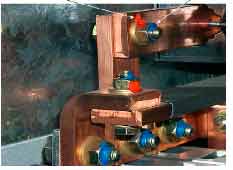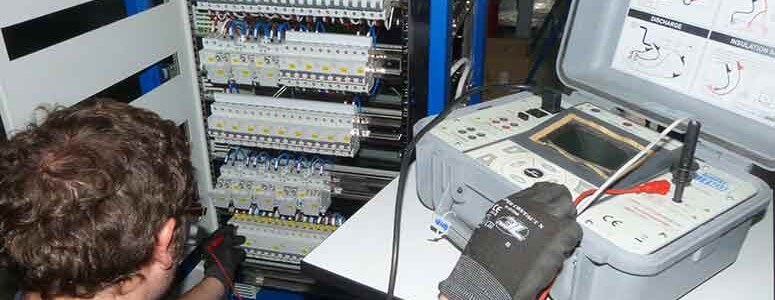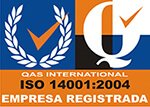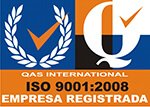Guide to a quality control system for electrical cabinets.
In electrical cabinets, as with other products, it is important to have a quality assurance system. This system warrantees not only the quality of each individual cabinet but a uniform engineering, manufacturing and documentation standard for all cabinets delivered by the company. The quality assurance system warrantees that, regardless the project manager and the staff that has participated in a project, the final product has the same quality, maintainability and support as any other product of the company. This warrantee has to be clearly identifiable in the manufactured products, normally by quality stamps.
Following there are some of activities we carry out in Wico. These and other activities are covered in our quality assurance plan which describes how all processes have to be carried out. This set of particular activities is focused on preventing failures.
Industrial electrical cabinet control inspections
There will be three control inspections for the industrial electrical cabinets.
- 1st inspection: to be carried out by the quality responsible.
- 2nd inspection: to be carried out by the project manager.
- 3rd inspection: to be carried out by the quality responsible.
For it to be simpler and more schematic we are going to describe the actions carried out in each of the manufacture phases of an industrial electrical cabinet. There will also be an explanation of the reason for each action and the associated inspection. All this will be detailed in a chronological order.
- The project manager delivers the project manufacture documentation to the quality responsible. The quality responsible verifies this documentation follows the company standards and that it is enough and adequate to start the manufacture. All equipment to be installed is marked with a label that identifies it uniquely among all equipment of any cabinet being manufactured. This action establishes a first filter for the materials supplied by third parties.
- The manufacture process starts at the workhouse with all the documentation verified, all the equipment labelled and the different tasks assigned to particular staff members.
First inspection of industrial electrical cabinets
Once the mounting plate has been machined, the equipment has been installed and the cabling works have started a first inspection is carried out. This first inspection seeks for design problems, mainly regarding equipment installation, that would, in case they are detected later on, make us redo a lot of work in order to keep up with the specifications.
The inspected items are:
- Correspondence between installed equipment and drawings: it has to be verified that the installed equipment are exactly the same as defined in the project drawings and BOM.
- Equipment labelling: It has to be verified that all equipment are labelled and that the label corresponds to the equipment identification in drawings.
- Cable trunk verification: Correct dimensions and installation must be verified.
- Cable colour verification: All projects include a cable definition sheet. Among others the cable colour and insulator is defined in this document. The colours and insulators of the cables being used are checked against the specification in the project.
- Equipment installation. The place, position and installation method of the equipment is verified against the project drawings.
- General verification. Overall verification that there are no design errors such as non-accessible terminal blocks, cable ways difficult to perform, etc.
After carrying out this inspection the responsible fills out the inspection form, signs it and sticks a blue label in the mounting plate or the enclosure structure with the inspection date and the responsible’s signature. In this way we warrantee the inspection has been carried out and passed.

Second inspection of industrial electrical cabinets.
Second inspection in the manufacture of electrical cabinets
The second inspection includes, apart from functional tests and mandatory tests and verifications according to the standard used for manufacturing (IEC, UL, etc), a set of additional verifications we use to warrantee quality.
As a general rule it will the project manager or the designated person to carry out the inspection 2 the person in charge of carrying out the functional and standard mandatory tests too.
To carry out the second inspection all manufacture works, cabling, equipment installation, enclosure fixing, etc. must be finished. This is responsibility of the person in charge of manufacturing and has to be verified by the presence of the manufacturing label.

White label for control of cabinet manufacture.
The label must be present in all manufactured parts: mounting plate, cubicles in the case of withdrawable cabinets, doors if there is equipment installed on them and bus-bar compartments. In the case of bus-bars all joints must have been verified and inspected. For verification a certified dynamometric tool has to be used. To show verification and inspection has been carried out joints are marked with two different colors.
Example:

Industrial electrical cabinet bus-bar joint sealing.
In the example of the photograph both seals can be seen: verification and inspection.
The inspector will stick a signed label with the inspection date.
These labels must be present in all inspected areas of the cabinet. In our case they are red.

Red label for the second inspection of the cabinet.
Conductor cross section and isolation has to be verified. These must be the ones specified in the documentation. Installation of these must also be verified including the protection degree, usually IP21, to prevent accidental direct contact.
The protection barriers are usually made of polycarbonate and have to have, duly, an electrical risk annunciation label.
The door labelling, both internal and external has to be verified, checking that all elements in the door have an external label indicating clearly their functionality. Internal labels must have the same identifications as the equipment has in the electrical drawings.
In the case of special communication cables like profibus, profinet, Ethernet, etc. it must be verified there is a correct identification label at both ends.
Earthing plates or bus-bars have to be verified checking for the correct cross section, installation and for the presence of sufficient connection drills.
Earth connection in doors must be verified for all of them and, additionally, all structural elements that may need a direct earth connection.
The electrical cabinet must have all necessary information. These documents have to be placed in a document holder, which is mandatory according to the green tag procedure. This procedure states as minimum documentation to include:
- As-built drawings.
- Installation, maintenance and user instructions.
- Equipment manuals.
As a last item to be inspected the industrial electrical cabinet must have an identification and characteristics plate. This plate must also include a serial number, the date of manufacture and all seals or logos according to the manufacture standard used, for example the CE logo.
CE marking for Wico inductrial electrical cabinets.
Once all the previous items along with:
- Isolation and dielectric strength
- Equipment energization.
- Functional tests.
Third inspection of industrial electrical cabinets.
The aim of the third inspection is to warrantee a uniform and adequate termination of all cabinets. Therefore all these third inspections are carried out by the quality responsible.
All labels regarding the previous inspections are verified. They must be clearly signed and with the correct dates according to inspection documents.
The included documentation is verified.
Cable trunks must be closed, correctly fixed and without any scratch. The same for contact protections. These must be thoroughly checked as they have to be dismounted for electrical tests.
Equipment labelling, cabinet plate including a serial number being the same as the one present in test documents and general documentation are verified too.
Once finished the cabinet is labelled for the third inspection pass with a yellow label.
Yellow label for inspection 3 control.
Once the third inspection is passed a packing form is filled by the inspector to allow the cabinet packing.
Special attention to be paid for industrial electrical cabinet packing. In the packing process of electrical cabinets it must be verified that all necessary mounting accessories are included. In case the cabinet is packed in several parts all screws, bolts, plates for joining along with particular mounting instructions must be included.
The packing depends on the transportation means (terrestrial, maritime, aerial) and the way (single dispatch, grouped dispatch).
The Project manager is in charge of providing the delivery note with correct addresee (address, Company, person in charge, etc,)
A copy of all these documents must be included on an envelope in the exterior of one of the packages.
Finally a soft copy of all documents (some of them will have to be scanned) must be archived in the company servers.
- Scanned Electrical drawings used at the workhouse.
- Copy of the manuals
- Fotographs of the finished cabinets.
- Inspection documents (scanned)
- Final as-built documentation.
We hope you have liked this post, if it has been useful for you, please, share it.
We manufacture all kinds of low voltage electrical cabinets.
We do turnkey projects
Electrical cabinets for an industrial freezing systemivered








